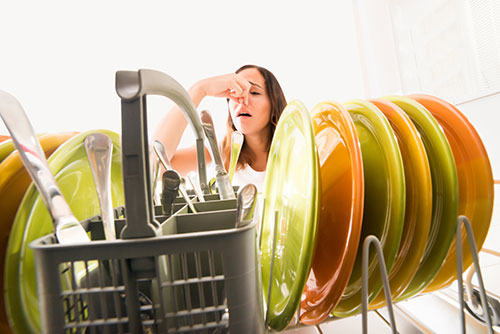A good dishwasher can be a godsend, especially after big family dinners, when the kitchen is piled with messy cookware, plates, glasses and utensils. Unfortunately, if you don’t regularly clean, disinfect and deodorize your unit, it will become inefficient, while polluting your kitchen with foul smells. Here is our step-by-step guide to cleaning this all-important kitchen appliance.
Step 1: Start with the filter. This step is crucial if you have a manual-clean filter, commonly found in newer units. Intended to replace the grinding mechanism on self-cleaning dishwashers, self-cleaning filters make modern dishwashers quieter. Unfortunately, they also trap food particles that become smelly as they spoil.
To clean your filter, start by pulling out the bottom rack. Depending on the brand and model, you will usually see a center cylinder that will unscrew, allowing you to remove the system and disassemble it. Once you’ve separated the parts, clean each one in the sink, using a sponge or your faucet sprayer. You may need to use a very small brush to dislodge grainy particles or coffee grounds, which can clog the mesh within the filter.
While the parts are removed, take a moment to check the spray arm to see if foods scraps are trapped within. It will usually come right out with a gentle tug. Wash the arm under running water, while looking for clogged holes, which you can clean using a wooden skewer or toothpick.
Depending on the brand or model, your spray arm may have an additional hole on its underside, designed to force water into the filter. If so, check to see if it is clogged, and then carefully reinstall both the spray arm and filter system.
Step 2: Deodorize and sanitize. After repeated use, residues, odors and discolorations can all accumulate within the interior of a dishwasher. You can eliminate all three using white vinegar. Start by adding two cups of vinegar to a clean bowl. Place the bowl near the center of the lower dish rack. Run the unit on the normal wash cycle without adding any detergent. As the vinegar is dispersed throughout the cycle, it will deodorize and sanitize your dishwasher.
If discoloration persists, it is likely because of mineral deposits from hard water. In this case, you will need to use a more aggressive store-bought dishwasher cleaner. You may also want to consider investing in a hard-water softener, since hard water does have the potential to shorten the lifespan of dishwasher units.
Step 3: Clean the exterior. If the front of your unit is plastic, scrub it down with hot, soapy water, using a sponge. If the front of your dishwasher is stainless steel, you can use glass cleaner to eliminate smudges, fingerprints and built-up grime. Be careful not to spray cleaner onto the surface, since this can create mist, which could damage the unit’s electronic controls. Instead, spray the cleaner into a cloth or paper towel, and then wipe the surface down.
2-10 HBW offers the most comprehensive Home Warranty coverage for homeowners. Let us help you protect your home.








